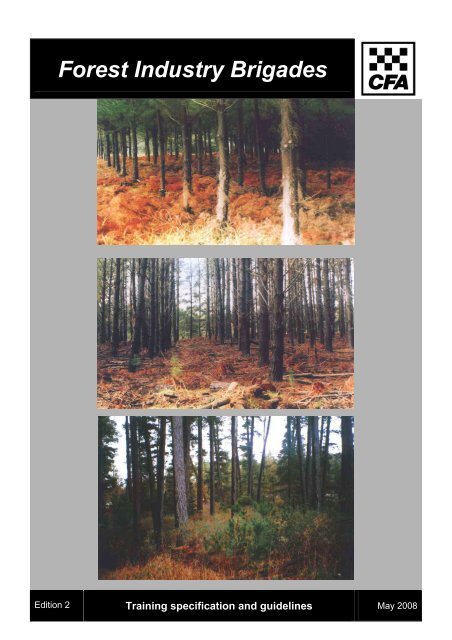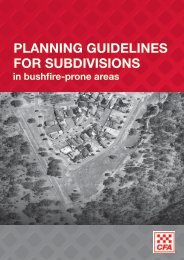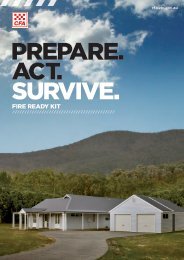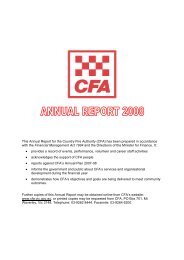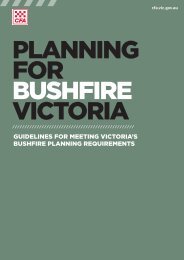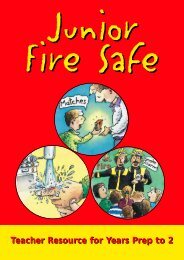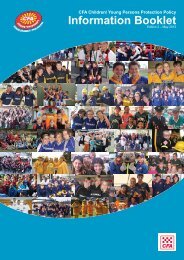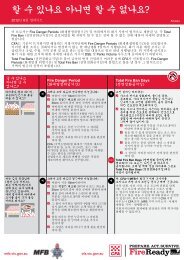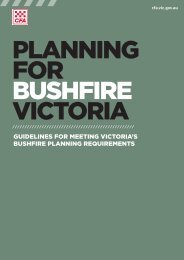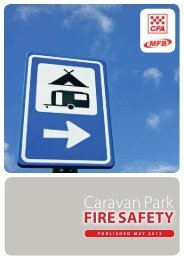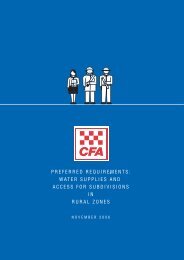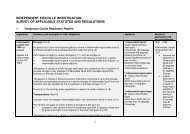Training Specifications and Guidelines - Country Fire Authority
Training Specifications and Guidelines - Country Fire Authority
Training Specifications and Guidelines - Country Fire Authority
You also want an ePaper? Increase the reach of your titles
YUMPU automatically turns print PDFs into web optimized ePapers that Google loves.
Forest Industry Brigades<br />
Edition 2 <strong>Training</strong> specification <strong>and</strong> guidelines May 2008
Forest Industry Brigade<br />
<strong>Training</strong> Specification <strong>and</strong> <strong>Guidelines</strong><br />
CONTENTS<br />
INTRODUCTION........................................................................................................................ 3<br />
Purpose .................................................................................................................................. 3<br />
Chief Officer’s requirements ................................................................................................... 3<br />
AUSTRALIAN QUALITY TRAINING FRAMEWORK.................................................................. 4<br />
Application of the AQF framework within CFA........................................................................ 4<br />
FIB members .......................................................................................................................... 5<br />
IMPLEMENTATION ................................................................................................................... 6<br />
Area Learning & Development structure................................................................................. 6<br />
Planning procedure .............................................................................................................6<br />
Scheduling <strong>and</strong> notification ................................................................................................. 6<br />
Quality control......................................................................................................................... 6<br />
Course content.................................................................................................................... 6<br />
Course providers................................................................................................................. 6<br />
Course delivery <strong>and</strong> skills recognition ................................................................................. 6<br />
Competency strength..............................................................................................................7<br />
Funding................................................................................................................................... 7<br />
Records management ............................................................................................................ 7<br />
SKILLS DEVELOPMENT ........................................................................................................... 8<br />
Specialist courses................................................................................................................... 8<br />
Endorsement process............................................................................................................. 8<br />
Skills maintenance.................................................................................................................. 9<br />
LEARNING MATERIALS GUIDE ............................................................................................. 10<br />
Introduction........................................................................................................................... 10<br />
NON FIB MEMBERS................................................................................................................ 10<br />
Basic Wildfire Behaviour ................................................................................................... 10<br />
PLANTATION FIREFIGHTER.................................................................................................. 11<br />
Minimum Operational Skills for <strong>Fire</strong>fighters – Wildfire .......................................................... 11<br />
PUAFIR201A Prevent injury............................................................................................. 11<br />
PUAOHS002A Maintain safety at an incident scene.......................................................... 12<br />
PUAFIR204A Respond to wildfire .................................................................................... 13<br />
PUAFIR309A Operate pumps .......................................................................................... 14<br />
PUAOPE002A Operate communications systems <strong>and</strong> equipment .................................... 14<br />
PUATEA001A Work in a team........................................................................................... 15<br />
CFA007 Plantation <strong>Fire</strong>fighting 1 ............................................................................. 16<br />
CREW LEADER....................................................................................................................... 16<br />
PUATEA002A Work autonomously ................................................................................... 16<br />
PUACOM001B Communicate in the workplace.................................................................. 17<br />
INCIDENT CONTROLLER 1.................................................................................................... 18<br />
PUAOPE001A Supervise response ................................................................................... 18<br />
PUALAW001A Protect <strong>and</strong> preserve incident scene.......................................................... 19<br />
PUAFIR303A Suppress wildfire........................................................................................ 20<br />
Other roles ............................................................................................................................... 21<br />
Edition 2,<br />
May 2008 Safety First Page 2
INTRODUCTION<br />
Purpose<br />
Forest Industry Brigade<br />
<strong>Training</strong> Specification <strong>and</strong> <strong>Guidelines</strong><br />
Regulation 72 of the Forestry Industry Brigade Regulations 2004 states; that the training requirements<br />
for officers <strong>and</strong> members of Forest Industry Brigades (FIBs) are those determined in Regulation 42 for<br />
members operating in forest. Each member of a Forest Industry Brigade must comply with the training<br />
requirements applicable to that Officer or member.<br />
The purpose of this publication is to:<br />
identify the training requirements for FIBs;<br />
put these requirements into context with regard to national accreditation;<br />
explain how this training is to be implemented;<br />
explain the skills development path, recognition <strong>and</strong> assessment process; <strong>and</strong><br />
identify the learning materials that support members to acquire the appropriate skills for their role.<br />
Chief Officer’s requirements<br />
The Chief Officer requires that:<br />
Forestry Industry Brigade officers <strong>and</strong> members maintain appropriate plantation firefighting skills at<br />
a level commensurate with the role expected of them on the fireground <strong>and</strong> in the incident<br />
management team;<br />
all employees <strong>and</strong> contractors likely to be deployed for non-combatant duties including the<br />
supervision of heavy machinery on the fireground must, as a minimum, have successfully<br />
completed the Public Safety <strong>Training</strong> Package unit “Maintain safety at an incident scene”<br />
(PUAOHS002A) or agreed equivalent;<br />
all Forestry Industry Brigade members must, as a minimum, have successfully completed the units<br />
of competency identified in the CFA Wildfire firefighter skills profile <strong>and</strong> in addition Plantation<br />
<strong>Fire</strong>fighting 1;<br />
all crew leaders on the fireground must, as a minimum, be assessed as satisfactorily meeting the<br />
skills profile required for Wildfire Crew Leader;<br />
all members (employees, contractors, officers <strong>and</strong> crew leaders) using Class A foam must be<br />
assessed as competent. <strong>and</strong><br />
each Forestry Industry Brigade or parent company is to nominate a <strong>Training</strong> Officer whose tasks are<br />
to identify the training needs of the brigade, consult with the CFA Area Manager <strong>Training</strong> <strong>and</strong><br />
Development about scheduling training, document competencies of brigade personnel <strong>and</strong> report<br />
same to Operations Manager as required.<br />
The Chief Officer also expects that:<br />
where possible, attendees at a training course are a mix of industry brigade personnel <strong>and</strong><br />
volunteer brigade personnel to ensure rapport is established, ideas are shared <strong>and</strong> mutual<br />
underst<strong>and</strong>ing <strong>and</strong> teamwork is fostered;<br />
Edition 2,<br />
May 2008 Safety First Page 3
Forest Industry Brigade<br />
<strong>Training</strong> Specification <strong>and</strong> <strong>Guidelines</strong><br />
AUSTRALIAN QUALITY TRAINING FRAMEWORK<br />
Background<br />
The competency st<strong>and</strong>ards used by CFA are drawn from a number of nationally endorsed training<br />
packages including the Public Safety <strong>Training</strong> Package (PSTP). This allows the firefighter in any state<br />
to progress through a curriculum <strong>and</strong> gain accreditation which is recognised nationally. In addition, the<br />
framework allows for accreditation in add-on skills <strong>and</strong> knowledge in specific areas, one of which is<br />
plantation firefighting.<br />
All CFA training is competency based <strong>and</strong> in accordance with st<strong>and</strong>ards set by the industry at a<br />
national level. It is appreciated that many companies which have formed FIBs also has a similar<br />
situation associated with the training of its personnel.<br />
As a Registered <strong>Training</strong> Organisation (RTO) operating under the Australian Quality <strong>Training</strong><br />
Framework (AQTF) st<strong>and</strong>ards values the skills <strong>and</strong> knowledge gained by members. CFA uses the<br />
recognition of prior learning (RPL) <strong>and</strong> recognition of current competency (RCC) as part of our skills<br />
recognition system. RPL <strong>and</strong> RCC are an integral part of a competency based educational <strong>and</strong> training<br />
system. These processes recognise the competencies which people already possess through formal<br />
study, work experience or life experience.<br />
CFA reserves the right to develop <strong>and</strong> implement specialist courses <strong>and</strong> programs to meet identified<br />
risks. The Plantation <strong>Fire</strong>fighting programs have been developed to meet the specific risks identified in<br />
plantations.<br />
Personnel operating within the plantation environment are required to satisfy the wildfire firefighter<br />
competencies for their level plus specialist plantation competencies.<br />
Application of the AQF framework within CFA<br />
These tables describe roles <strong>and</strong> responsibilities for each role within the framework.<br />
Plantation <strong>Fire</strong>fighter (AQF Level 2)<br />
Role To work under the supervision of the Crew Leader as part of a team.<br />
Responsibilities To safely, effectively <strong>and</strong> efficiently carry out allocated tasks.<br />
Crew Leader (AQF 3)<br />
Role To task <strong>and</strong> supervise the crew (sized appropriately in number to carry out their allocated task) in<br />
accordance with the Incident Action Plan, considering safety <strong>and</strong> welfare of personnel as the first<br />
priority. To continually evaluate <strong>and</strong> report on the current <strong>and</strong> future situation, monitor <strong>and</strong> review the<br />
effectiveness of tasks <strong>and</strong> tactics, <strong>and</strong> communicates up <strong>and</strong> down the chain of comm<strong>and</strong>.<br />
Responsibilities Overall management <strong>and</strong> supervision of the crew when allocated, available <strong>and</strong> out of<br />
service. To have the appropriate skills to ensure all personnel under their control work safely, effectively<br />
<strong>and</strong> efficiently.<br />
Incident Controller Level 1 (AQF 3)<br />
Role Act as Incident Controller at a Level 1 incident. To continually evaluate <strong>and</strong> report on the current<br />
<strong>and</strong> future situation, monitor <strong>and</strong> review the effectiveness of tasks <strong>and</strong> tactics.<br />
Responsibilities Overall management <strong>and</strong> supervision of the crew when allocated, available <strong>and</strong> out of<br />
service. To have the appropriate skills to ensure all personnel under their control work safely, effectively<br />
<strong>and</strong> efficiently to achieve planned objectives <strong>and</strong> outcomes using AIIMS <strong>and</strong> in accordance with Chief<br />
Officer’s St<strong>and</strong>ard Operating Procedures <strong>and</strong> Chief Officer’s St<strong>and</strong>ing Orders.<br />
Edition 2,<br />
May 2008 Safety First Page 4
Forest Industry Brigade<br />
<strong>Training</strong> Specification <strong>and</strong> <strong>Guidelines</strong><br />
Strike Team Leader (AQF Level 3)<br />
Role To task <strong>and</strong> supervise the strike team, to carry out allocated task(s) in accordance with the<br />
Incident Action Plan, considering safety <strong>and</strong> welfare of personnel as the first priority. To continually<br />
evaluate <strong>and</strong> report on the current <strong>and</strong> future situation, monitor <strong>and</strong> review the effectiveness of tactics<br />
used to achieve the strategies <strong>and</strong> objectives of the Incident Action Plan <strong>and</strong> communicate up <strong>and</strong><br />
down the chain of comm<strong>and</strong>. May act as Incident Controller at a Level 1 incident, may perform<br />
specialist tasks under limited supervision in the incident management team.<br />
Responsibilities Overall management <strong>and</strong> supervision of the strike team when allocated, available <strong>and</strong><br />
out of service. To have the appropriate skills to ensure all personnel under his or her control work<br />
safely, effectively <strong>and</strong> efficiently to achieve planned objectives <strong>and</strong> outcomes using AIIMS <strong>and</strong> in<br />
accordance with Chief Officer’s St<strong>and</strong>ard Operating Procedures <strong>and</strong> Chief Officer’s St<strong>and</strong>ing Orders.<br />
Sector Comm<strong>and</strong>er (AQF Level 4)<br />
Role To implement the strategies of the incident control plan for the sector, contribute to the<br />
development of strategies for incident control <strong>and</strong> to manage people <strong>and</strong> resources tasked with these<br />
strategies, with the safety <strong>and</strong> welfare of personnel the primary consideration. To continually evaluate<br />
<strong>and</strong> report on the current <strong>and</strong> future situation, monitor <strong>and</strong> review the effectiveness of the control plan<br />
for the sector <strong>and</strong> communicate up <strong>and</strong> down the chain of comm<strong>and</strong>. May act as Incident Controller at a<br />
Level 1 incident. Sector Comm<strong>and</strong>er at a Level 2 or Level 3 incident. If appropriately qualified, may<br />
perform roles in an incident management team at a Level 2 or Level 3 incident, without supervision.<br />
Responsibilities To have the appropriate skills to ensure all personnel under his or her control work<br />
safely, effectively <strong>and</strong> efficiently to achieve planned objectives <strong>and</strong> outcomes using AIIMS <strong>and</strong> in<br />
accordance with Chief Officer’s St<strong>and</strong>ard Operating Procedures <strong>and</strong> Chief Officer’s St<strong>and</strong>ing Orders.<br />
FIB members<br />
The chart below details the skills development path for FIB operational roles from Plantation <strong>Fire</strong>fighter<br />
through to Sector Comm<strong>and</strong>er.<br />
FIB OPERATIONAL ROLE SKILLS DEVELOPMENT PATHWAY<br />
Plantation<br />
<strong>Fire</strong>fighter<br />
Crew Leader Incident<br />
Controller 1<br />
Strike Team<br />
Leader<br />
Sector<br />
Comm<strong>and</strong>er<br />
<br />
Wildfire<br />
firefighter<br />
Wildfire<br />
firefighter<br />
Wildfire<br />
firefighter<br />
Wildfire<br />
firefighter<br />
Wildfire<br />
firefighter<br />
<br />
Plantation<br />
<strong>Fire</strong>fighting<br />
Plantation<br />
<strong>Fire</strong>fighting<br />
Plantation<br />
<strong>Fire</strong>fighting<br />
Plantation<br />
<strong>Fire</strong>fighting<br />
Plantation<br />
<strong>Fire</strong>fighting<br />
<br />
Crew<br />
Leadership<br />
Crew<br />
Leadership<br />
Crew<br />
Leadership<br />
Crew<br />
Leadership<br />
<br />
Wildfire 2 Wildfire 2 Wildfire 2<br />
<br />
Incident<br />
Controller 1<br />
Incident<br />
Controller 1<br />
Incident<br />
Controller 1<br />
<br />
<br />
Strike Team<br />
Leader<br />
Strike Team<br />
Leader<br />
<br />
Sector<br />
Comm<strong>and</strong>er<br />
Edition 2,<br />
May 2008 Safety First Page 5
IMPLEMENTATION<br />
Forest Industry Brigade<br />
<strong>Training</strong> Specification <strong>and</strong> <strong>Guidelines</strong><br />
The following information outlines the procedures to be followed in implementing a training regime for<br />
FIBs.<br />
Area Learning & Development structure<br />
The Manager <strong>Training</strong> & Development in each area is responsible for the area’s overall training delivery<br />
portfolio.<br />
Planning procedure<br />
Requests for specific courses from industry, brigade <strong>and</strong> area staff are to be channelled through the<br />
Area Manager <strong>Training</strong> & Development in the first instance.<br />
The Chief Officer or area <strong>and</strong> regional management teams may encourage specific courses or specific<br />
training outcomes via this process.<br />
Scheduling <strong>and</strong> notification<br />
Area Manager <strong>Training</strong> & Development Area training managers are to ensure that FIBs receive a copy<br />
of the area/region’s general training program calendar which should also include information specific to<br />
the CFA advanced training program.<br />
Quality control<br />
The following quality control measures are to be adhered to.<br />
Course content<br />
The Manager, <strong>Training</strong> <strong>and</strong> Development is to ensure that the training course material <strong>and</strong> course<br />
delivery is compatible with agreed competency requirements <strong>and</strong> expectations.<br />
Course providers<br />
Course providers engaged to deliver plantation firefighter courses are to do so in accordance with the<br />
agreed learning <strong>and</strong> assessment strategy <strong>and</strong> the Chief Officer’s requirements.<br />
Providers engaged to deliver plantation firefighting courses are to be selected from CFA accredited<br />
providers. Accreditation will be provided by the Manager, Forestry Industry Brigades. An updated list<br />
will be sent out annually to training managers <strong>and</strong> FIB nominated training coordinators.<br />
Course delivery <strong>and</strong> skills recognition<br />
CFA, as a registered training provider, will issue “statements of attainment” to members who<br />
successfully complete the training <strong>and</strong> skills recognition requirements.<br />
To facilitate this process the provider delivering <strong>and</strong> assessing the training must hold the appropriate<br />
industry competency st<strong>and</strong>ards <strong>and</strong> appropriate delivery <strong>and</strong>/or assessment competencies.<br />
Delivery st<strong>and</strong>ards<br />
TAADEL401A Plan <strong>and</strong> organise group-based delivery<br />
TAADEL402A Facilitate group-based learning<br />
Assessment st<strong>and</strong>ard<br />
TAAASS401A Plan <strong>and</strong> organise assessment<br />
TAAASS402A Assess competence<br />
TAAASS404A Participate in assessment validation<br />
Edition 2,<br />
May 2008 Safety First Page 6
Forest Industry Brigade<br />
<strong>Training</strong> Specification <strong>and</strong> <strong>Guidelines</strong><br />
All skills recognition activities require the involvement of a qualified workplace assessor who must be<br />
competent in the subject being assessed or have access to a subject or technical specialist.<br />
Equivalent workplace trainer <strong>and</strong> assessor competencies are considered acceptable <strong>and</strong> suitable<br />
where appropriate.<br />
Where a subject matter expert is used to deliver <strong>and</strong> assess the members they must be supervised by<br />
someone who holds a Certificate IV in <strong>Training</strong> <strong>and</strong> Assessment, or the units identified above or<br />
equivalent.<br />
It is important for FIB parent companies to ensure this is taken into account when arranging in-house<br />
training programs. Workplace assessment can either be provided as part of the training package or<br />
arranged separately.<br />
Competency strength<br />
The Region Operations Manager is to check the competency strength of all industry brigades prior to<br />
the start of the summer wildfire season each year (by end of November) using the Section 29<br />
Inspection process. This will identify any skill gaps <strong>and</strong> allow for planning to address training issues.<br />
Funding<br />
Costs associated with training FIB members are the responsibility of the parent company. Where FIB<br />
members are students on internally conducted CFA courses, CFA may invoice the FIB parent company<br />
the actual costs CFA incurred in delivering the training to FIB members as a proportion of the number of<br />
students on the course.<br />
To encourage cooperation between volunteers <strong>and</strong> FIB members at a local level, CFA offers significant<br />
discounts on training charges when FIB members attend local competency based volunteer training<br />
courses.<br />
FIB parent companies are advised to contact their CFA <strong>Training</strong> Manager to confirm current CFA<br />
course prices.<br />
Records management<br />
Each FIB is responsible to ensure that a copy of all training <strong>and</strong> skills maintenance records are<br />
forwarded to their Manager <strong>Training</strong> <strong>and</strong> Development so that the information can be recorded on<br />
TRAIN (<strong>Training</strong> Record System). Each FIB should also retain a copy of these records for each<br />
member they employ.<br />
Edition 2,<br />
May 2008 Safety First Page 7
Forest Industry Brigade<br />
<strong>Training</strong> Specification <strong>and</strong> <strong>Guidelines</strong><br />
SKILLS DEVELOPMENT<br />
CFA remains committed to providing opportunities for all personnel to maximise their potential. These<br />
opportunities will be provided through a combination of in-house, training contractors <strong>and</strong> external<br />
development programs.<br />
Specialist courses<br />
In addition to the minimum requirements for FIB operational roles there are a range of specialist<br />
courses available these include; (in alphabetical order):<br />
Aircraft Officer (CFA/DSE);<br />
Air Attack Supervisor (CFA/DSE);<br />
Air Base Manager (CFA/DSE);<br />
Air Observer (CFA/DSE);<br />
CFA Sector Comm<strong>and</strong>er (CFA090);<br />
Driving vehicles under operational condition;<br />
Drive Vehicles Off Road;<br />
Provide emergency care;<br />
<strong>Fire</strong> Investigation - Wildfire (CFA267);<br />
Introduction to AIIMS (CFA404);<br />
Incident Management Skills (CFA504);<br />
Lead, manage <strong>and</strong> develop teams;<br />
Logistics Officer (CFA503);<br />
Operations Officer (CFA403);<br />
Planning Officer (CFA502);<br />
Pre-Incident Planning;(CFA);<br />
Plan a prescribed burn;(CFA216);<br />
Staging Area Management (CFA094); <strong>and</strong><br />
Supervise heavy machinery.(CFA213)<br />
For further details associated with the availability of these courses, location, costs <strong>and</strong> learning<br />
outcomes, contact your local Area Manager <strong>Training</strong> <strong>and</strong> Development or Operations Manager.<br />
Endorsement process<br />
For all Operational Management roles a process of endorsement is used to confirm that the individual is<br />
considered competent to perform the role. The endorsement process is simple. On successful<br />
completion of the skills recognition process for the operational role, a designated person will then<br />
consider the experience <strong>and</strong> capacity of the firefighter to undertake the role <strong>and</strong> endorse them for the<br />
role if appropriate. The endorsement for the role will be provided by an endorsee under delegation from<br />
the Chief Officer.<br />
Edition 2,<br />
May 2008 Safety First Page 8
Forest Industry Brigade<br />
<strong>Training</strong> Specification <strong>and</strong> <strong>Guidelines</strong><br />
Skills maintenance<br />
Skills maintenance is an ongoing process, if you don’t use your skills, over time you may lose part or all<br />
of them. There are ways to avoid this, one is to regularly turn out to fires or incidents <strong>and</strong> have this<br />
recorded, another is to take part in prescribed burning or simulation exercises where skills maintenance<br />
is completed to the satisfaction of your immediate supervisor. All skills maintenance must be<br />
appropriately recorded.<br />
Every plantation firefighter must be able to demonstrate on an annual basis that they are able to protect<br />
themselves from potential risks in firefighting by:<br />
wearing the correct protective clothing;<br />
selecting <strong>and</strong> using appropriate equipment;<br />
using water as protection;<br />
dealing appropriately with unexpected events, including the impacts of a wind change;<br />
recognising watchout situations <strong>and</strong> responding accordingly;<br />
underst<strong>and</strong>ing basic bushfire <strong>and</strong> grassfire behaviour, including risks from extreme wildfire<br />
behaviour;<br />
applying appropriate firefighting techniques using brigade equipment for the type of fire <strong>and</strong> fire<br />
behaviour experienced; <strong>and</strong><br />
starting the pump <strong>and</strong> delivering water from any outlet.<br />
If an FIB member can not satisfactorily meet any of these conditions, the person must be reassessed<br />
prior to the next fire season.<br />
Edition 2,<br />
May 2008 Safety First Page 9
Forest Industry Brigade<br />
<strong>Training</strong> Specification <strong>and</strong> <strong>Guidelines</strong><br />
LEARNING MATERIALS GUIDE<br />
Introduction<br />
This guide has been developed as an aid to identify:<br />
the subjects that are encompassed by a particular FIB role;<br />
the subject description;<br />
what it is you will need to know <strong>and</strong>/or be able to demonstrate about the subject to achieve skills<br />
recognition; <strong>and</strong><br />
what learning materials <strong>and</strong> information you will need to access to assist in underst<strong>and</strong>ing or<br />
revising the subject.<br />
Copies of learning manuals <strong>and</strong> other reference materials are available from your brigade. Contact your<br />
training officer to gain access to these materials.<br />
NON FIB MEMBERS<br />
All non FIB members used by the FIB (for example; plant operators) who may be required to enter the<br />
fireground must successfully complete a CFA “Maintain safety at an incident scene” program. In<br />
addition given the nature of the potential risks <strong>and</strong> operating environment for FIB contractors the<br />
following additional content must be included in the “Maintain safety at an incident scene” program.<br />
Basic Wildfire Behaviour<br />
Subject<br />
Description<br />
Describe how materials<br />
burn<br />
Identify the basic factors<br />
which affect fire<br />
behaviour<br />
Describe the<br />
development of wildfires<br />
Describe <strong>and</strong><br />
demonstrate basic fire<br />
suppression strategies<br />
<strong>and</strong> tactics<br />
Describe the risks <strong>and</strong><br />
hazards of firefighting<br />
<strong>and</strong> the precautions to be<br />
taken<br />
What you need to know or be able to demonstrate<br />
Knowledge<br />
Identify the elements required for a fire to exist; <strong>and</strong><br />
describe one common method to control each of these elements.<br />
List the three groups of factors that affect fire behaviour;<br />
describe the relationship between wind speed <strong>and</strong> direction, <strong>and</strong> the shape of a<br />
fire; <strong>and</strong> describe the effect of slope on fire behaviour.<br />
Explain the terms origin, head, flank <strong>and</strong> rate of spread;<br />
describe <strong>and</strong> contrast a ground, surface <strong>and</strong> crown fire; <strong>and</strong><br />
describe spotting, <strong>and</strong> its causes <strong>and</strong> effect on fire behaviour.<br />
Explain the differences between a “direct attack” (including parallel attack), <strong>and</strong><br />
“indirect attack”;<br />
explain the term “defensive firefighting” <strong>and</strong> give an example of its use;<br />
explain the difference between a head attack <strong>and</strong> a flank attack;<br />
explain what is meant by a “mineral earth break” <strong>and</strong> demonstrate how to<br />
construct one with a h<strong>and</strong>tool;<br />
demonstrate the correct use of a knapsack pump; <strong>and</strong> explain the meaning of<br />
the terms “fire suppression” <strong>and</strong> “mop-up”.<br />
Identify <strong>and</strong> describe the principal hazards, including the main risky wildfire<br />
scenarios, <strong>and</strong> precautions involved in wildfire firefighting;<br />
describe the use of potential fire shelters, including motor vehicles, in life<br />
threatening situations;<br />
identify the problems associated with insufficient water intake, food intake <strong>and</strong><br />
rest breaks, <strong>and</strong> inappropriate food intake;<br />
describe how to avoid, recognise <strong>and</strong> treat heat related illness;<br />
explain the purpose <strong>and</strong> limitations of protective clothing <strong>and</strong> equipment;<br />
explain why it is necessary to work as a team <strong>and</strong> the steps to be taken if there<br />
Edition 2,<br />
May 2008 Safety First Page 10
Forest Industry Brigade<br />
<strong>Training</strong> Specification <strong>and</strong> <strong>Guidelines</strong><br />
Materials<br />
Subject<br />
Description<br />
What you need to know or be able to demonstrate<br />
is no alternative to working alone; <strong>and</strong><br />
explain why it is necessary to have <strong>and</strong> follow instructions from your supervisor<br />
<strong>and</strong> to provide reports back to him or her.<br />
There are no learning materials required prior to attending the training course.<br />
PLANTATION FIREFIGHTER<br />
All members of a Forestry Industry Brigade (including officers) must as a minimum successfully acquire<br />
all of the designated competencies to be considered Plantation <strong>Fire</strong>fighter qualified.<br />
To qualify as a Plantation <strong>Fire</strong>fighter, you need to be assessed as competent in Minimum Operational<br />
Skills for <strong>Fire</strong>fighters – Wildfire <strong>and</strong> Plantation <strong>Fire</strong>fighting 1, in that order.<br />
Minimum Operational Skills for <strong>Fire</strong>fighters – Wildfire<br />
The following information is a guide to what you need to know or be able to do/demonstrate <strong>and</strong> directs<br />
you to the learning materials you will need to access prior to skills recognition.<br />
PUAFIR201A<br />
Descriptor<br />
Element<br />
1. Identify workplace<br />
hazards <strong>and</strong> risks <strong>and</strong><br />
advise others<br />
2. Implement hazard<br />
control procedures<br />
3. Review effectiveness of<br />
hazard control<br />
procedures<br />
4. Participate in the<br />
implementation of<br />
OH&S in the workplace<br />
Prevent injury<br />
This unit covers the competency associated with the identification, avoidance,<br />
review, <strong>and</strong> evaluation of workplace risks <strong>and</strong> hazards, maintenance of personal<br />
safety <strong>and</strong> the reporting to supervisors <strong>and</strong> team members.<br />
Performance criteria<br />
1. Procedures <strong>and</strong> practices are followed to identify workplace hazards <strong>and</strong> risks<br />
2. Appropriate procedures for dealing with hazards in the workplace are followed<br />
in accordance with Occupational Health <strong>and</strong> Safety (OH&S) guidelines <strong>and</strong> the<br />
organisation’s procedures<br />
3. Contact is maintained at all times with other crew members <strong>and</strong> supervisor<br />
4. Hazards in the work area <strong>and</strong> warnings of hazardous situations are recognised<br />
<strong>and</strong> reported to designated personnel<br />
5. Stressful situations are recognised <strong>and</strong> support is sought or given to minimise<br />
effect<br />
1. Personal protective clothing <strong>and</strong> equipment is selected <strong>and</strong> donned in<br />
accordance with the organisation’s procedures <strong>and</strong> within its limitations<br />
2. Appropriate procedures <strong>and</strong> work instructions for controlling risks <strong>and</strong> hazards<br />
are followed<br />
3. Personal health is protected in accordance with legislative <strong>and</strong> organisation’s<br />
procedures<br />
4. Equipment appropriate to dealing with a hazard is used in accordance with<br />
st<strong>and</strong>ard operating procedures<br />
5. Controls are implemented to minimise damage to the environment<br />
6. Fluid <strong>and</strong> food intake <strong>and</strong> rest breaks are maintained in accordance with<br />
environmental <strong>and</strong> working conditions <strong>and</strong> the organisation’s policy<br />
7. Assistance is given to crew members in danger while maintaining personal<br />
safety in accordance with the organisation’s procedures<br />
1. Hazard controls are monitored to ensure continued effectiveness<br />
2. Changes in incident behaviour <strong>and</strong> conditions are reported immediately to<br />
supervisor<br />
3. Factors which may create or increase risk to life, property or the environment<br />
are identified, reported <strong>and</strong> controlled in so far as possible<br />
1. OH&S issues are raised with designated personnel in accordance with<br />
procedures <strong>and</strong> OH&S legislation<br />
2. Contributions to OH&S implementation in the workplace are made within<br />
organisation’s procedures <strong>and</strong> scope of responsibilities <strong>and</strong> competencies<br />
3. Activities/debriefings are undertaken which alleviate occupational stress<br />
Edition 2,<br />
May 2008 Safety First Page 11
Forest Industry Brigade<br />
<strong>Training</strong> Specification <strong>and</strong> <strong>Guidelines</strong><br />
Element<br />
Critical aspects of<br />
evidence<br />
Performance criteria<br />
It is essential for this unit that competence be demonstrated in:<br />
correct identification of hazards in the workplace<br />
application of the organisation’s procedures including the correct selection<br />
<strong>and</strong> use of PPE<br />
advising <strong>and</strong> reporting of workplace hazards in accordance with the<br />
organisation’s requirements<br />
notification of risk to the team <strong>and</strong> supervisor in a timely manner<br />
PUAOHS002A<br />
Descriptor<br />
Maintain safety at an incident scene<br />
This unit covers the competency to recognise potential health <strong>and</strong> safety risks <strong>and</strong><br />
take action to eliminate or control those risks at incident scenes, to prevent injury<br />
to self, other personnel or members of the public.<br />
Element<br />
1. Determine hazards at<br />
incident site<br />
2. Implement hazard<br />
controls at incident<br />
scene<br />
3. Maintain personal<br />
safety<br />
4. Contribute to<br />
maintaining safety of<br />
other work group<br />
members<br />
Critical aspects of<br />
evidence<br />
Performance criteria<br />
1. Issues affecting safety of self <strong>and</strong> other personnel are established by<br />
identification of hazards <strong>and</strong> assessment of risks, <strong>and</strong> by liaison with others at<br />
the scene<br />
2. Relevant operational safety procedures are implemented in accordance with<br />
organisation’s policies<br />
3. Duties are undertaken in line with organisational health <strong>and</strong> safety codes of<br />
practice <strong>and</strong> relevant legislation<br />
1. Hazards are identified <strong>and</strong> mitigation procedures are selected in line with work<br />
instructions <strong>and</strong> procedures<br />
2. Hazardous situations rectified where possible <strong>and</strong> reported <strong>and</strong>/or recorded<br />
according to organisation’s policies <strong>and</strong> procedures<br />
3. Changes in situation <strong>and</strong>/or conditions are reported immediately to designated<br />
person<br />
4. Hazard controls are monitored <strong>and</strong> communicated to relevant personnel to<br />
ensure continuing effectiveness<br />
5. Hazard control <strong>and</strong> mitigation measures are implemented with minimum<br />
damage to the environment, while maintaining safety of self <strong>and</strong> others<br />
6. Incident/accident scene is effectively secured to preserve the scene <strong>and</strong><br />
maintain public safety in line with legislative requirements<br />
1. Personal protective clothing <strong>and</strong> equipment is selected <strong>and</strong> checked according<br />
to organisational procedures to ensure it is operational prior to entry into<br />
incident situation<br />
2. Personal protective clothing <strong>and</strong> equipment appropriate to dealing with the<br />
hazard is worn/fitted <strong>and</strong> used in accordance with organisation’s policies <strong>and</strong><br />
procedures <strong>and</strong> manufacturer’s guidelines<br />
3. Water <strong>and</strong> food intake, rest breaks <strong>and</strong> shelter requirements are maintained<br />
4. Survival technique strategies are implemented in accordance with<br />
organisation’s policies <strong>and</strong> guidelines<br />
1. Impact of own actions on safety of others is recognised<br />
2. Contact is maintained at all times with other work group members<br />
3. Signals are correctly used, interpreted, confirmed <strong>and</strong> acted upon in a timely<br />
manner<br />
4. Warnings of hazardous situations are clearly relayed to work group members<br />
using appropriate terminology <strong>and</strong> codes<br />
5. Assistance is given to work group members in danger in accordance with<br />
st<strong>and</strong>ard operating procedures, ensuring personal safety is maintained<br />
It is essential for this unit that competence be demonstrated in<br />
maintaining personal safety <strong>and</strong> safety of others<br />
Edition 2,<br />
May 2008 Safety First Page 12
Forest Industry Brigade<br />
<strong>Training</strong> Specification <strong>and</strong> <strong>Guidelines</strong><br />
PUAFIR204A<br />
Descriptor<br />
Respond to wildfire<br />
This unit covers competency for responding to a wildfire when working as a<br />
member of a team, under direct supervision.<br />
Element<br />
1. Prepare to respond to<br />
fire<br />
Performance criteria<br />
1. The location of fire <strong>and</strong> the most effective route to the fire are obtained taking<br />
into account local conditions<br />
2. Protective clothing <strong>and</strong> equipment, food <strong>and</strong> fluid requirements are identified<br />
<strong>and</strong> relevant preparations undertaken prior to departure<br />
2. Proceed to fire 1. The location of the fire is confirmed on approach<br />
2. Access to the area is gained with minimum injury to personnel or damage to<br />
vehicles, equipment or the environment<br />
3. Evidence of fire cause is noted <strong>and</strong> brought to the attention of the supervisor<br />
3. Obtain <strong>and</strong> use<br />
extinguishing media<br />
<strong>and</strong> equipment<br />
1. Nominated media <strong>and</strong> equipment are located <strong>and</strong> obtained<br />
2. Equipment is used to deliver the nominated media in accordance with the<br />
organisation’s <strong>and</strong> manufacturer's procedures<br />
4. Combat wildfire 1. Instructions are received, confirmed <strong>and</strong> implemented in accordance with the<br />
organisation’s safe work practices <strong>and</strong> procedures<br />
2. Equipment <strong>and</strong> extinguishing media used are appropriate to wildfire conditions<br />
3. Control lines are prepared in accordance with the organisation’s procedures<br />
4. Equipment is positioned, made ready for use <strong>and</strong> protected from damage in<br />
accordance with the organisation’s procedures<br />
5. <strong>Fire</strong> is attacked taking into account wildfire hazards as directed <strong>and</strong> in<br />
accordance with the organisation’s procedures<br />
6. Evidence of fire cause <strong>and</strong> area of fire origin are protected<br />
7. Communication is maintained at all times in accordance with the organisation’s<br />
procedures<br />
5. Observe <strong>and</strong> react to<br />
wildfire <strong>and</strong> weather<br />
conditions<br />
6. Participate in mop-up<br />
<strong>and</strong> patrol activities<br />
7. Assist in ancillary<br />
operations<br />
8. Recover <strong>and</strong> store<br />
equipment<br />
Critical aspects of<br />
evidence<br />
1. Conditions at the fire are observed <strong>and</strong> their effect on fire behaviour <strong>and</strong><br />
development are noted <strong>and</strong> reported to supervisor<br />
2. Weather conditions <strong>and</strong> changes to fire behaviour are observed <strong>and</strong> reported<br />
to the supervisor<br />
3. Variations in terrain, fuel types <strong>and</strong> fuel arrangements are observed <strong>and</strong> the<br />
effect on fire behaviour is reported to the supervisor as required<br />
4. A safe escape route or refuge is identified <strong>and</strong> maintained at all times<br />
5. Communication is maintained with other <strong>Fire</strong>fighting personnel <strong>and</strong> the<br />
supervisor throughout operational activities<br />
1. Mopping-up activities are carried out under direction in accordance with the<br />
organisation’s procedures<br />
2. Patrol of the perimeter or sector of the fire is maintained in accordance with<br />
the organisation’s procedures<br />
1. Activities to complement firefighting operations are carried out as directed <strong>and</strong><br />
according to the organisation’s procedures<br />
1. Equipment <strong>and</strong> consumables are recovered as directed<br />
2. Equipment is stored in accordance with the organisation’s procedures<br />
3. Cleaning <strong>and</strong> maintenance are carried out in accordance with the<br />
organisation’s procedures<br />
For this unit it is essential that competence be demonstrated<br />
by:<br />
reacting to changing wildfire behaviour due to changes in weather, topography<br />
<strong>and</strong> fuel conditions<br />
participating in dry wildfire control<br />
use of extinguishing media in wildfire control<br />
maintaining health <strong>and</strong> safety of self, other workers <strong>and</strong> people in the<br />
immediate work area<br />
participating in mop-up <strong>and</strong> patrol<br />
undertaking operational activities safely<br />
Edition 2,<br />
May 2008 Safety First Page 13
Forest Industry Brigade<br />
<strong>Training</strong> Specification <strong>and</strong> <strong>Guidelines</strong><br />
PUAFIR309A<br />
Descriptor<br />
Operate pumps<br />
This unit covers the competency to operate portable <strong>and</strong><br />
appliance-mounted pumps at an incident.<br />
Element<br />
1. Prepare pump to deliver<br />
water<br />
Performance criteria<br />
1. Type of pump selected is appropriate to the operation/incident<br />
2. Suitability of water supply is determined<br />
3. Pump is sited <strong>and</strong> positioned to receive <strong>and</strong> deliver water supply in<br />
accordance with the organisation’s requirements<br />
4. Pump is engaged in accordance with the manufacturer’s guidelines <strong>and</strong> the<br />
organisation’s procedures<br />
5. Appropriate agents are prepared for the production of foam at an incident,<br />
where required<br />
2. Operate pump 1. Pump components, ancillary equipment <strong>and</strong> principles of operation are utilised<br />
to draught water from a static supply, to boost water from a reticulated supply<br />
or to deliver water from the appliance tank<br />
2. Pump operation is in accordance with manufacturer's specifications,<br />
organisation’s procedures <strong>and</strong> OH&S guidelines<br />
3. Hydraulic requirements of hose lines <strong>and</strong> branches are calculated<br />
4. Pumps are operated to ensure that pressure <strong>and</strong> flow meet operational<br />
requirements <strong>and</strong> safety to personnel is maintained<br />
5. Pump performance is monitored <strong>and</strong> maintained to ensure maximum efficiency<br />
of operation, to detect <strong>and</strong> correct pumping <strong>and</strong> safety problems <strong>and</strong> to take<br />
appropriate action in accordance with the organisation’s procedures<br />
6. Pump operations are to be carried out avoiding injury to personnel <strong>and</strong><br />
damage to equipment <strong>and</strong> facilities<br />
7. Mechanical malfunctions are reported to supervisor according to the<br />
organisation’s procedures<br />
3. Conclude pump<br />
operations<br />
Critical aspects of<br />
evidence<br />
1. Pump operations are concluded in accordance with the organisation’s<br />
procedures<br />
2. Ancillary equipment is collected <strong>and</strong> stowed in accordance with the<br />
organisation’s requirements<br />
3. Maintenance procedures <strong>and</strong> checks are undertaken to ensure pump <strong>and</strong><br />
ancillary equipment is serviceable in accordance with the organisation’s<br />
requirements<br />
It is essential for this unit that competence be demonstrated in:<br />
maintenance of water supply to branch operators<br />
maintenance of appropriate levels of pressure<br />
responding appropriately to changing circumstances<br />
when using foam, the correct proportion of foam <strong>and</strong> water is<br />
supplied/delivered <strong>and</strong> supply of foam concentrate is maintained<br />
when pumping from an appliance tank, monitoring levels of water remaining in<br />
appliance tank to ensure minimum levels for crew protection<br />
pumping without injury to personnel or damage to equipment<br />
PUAOPE002A<br />
Descriptor<br />
Operate communications systems <strong>and</strong> equipment<br />
This unit covers the competency to transmit <strong>and</strong> receive communications in<br />
routine <strong>and</strong> operational situations using the organisation’s communication systems<br />
<strong>and</strong> equipment.<br />
Element<br />
1. Use communication<br />
systems <strong>and</strong> equipment<br />
Performance criteria<br />
1. Equipment is used <strong>and</strong> operated safely to support communications consistent<br />
with organisation’s policies <strong>and</strong> procedures<br />
Edition 2,<br />
May 2008 Safety First Page 14
Forest Industry Brigade<br />
<strong>Training</strong> Specification <strong>and</strong> <strong>Guidelines</strong><br />
Element<br />
2. Transmit <strong>and</strong> receive<br />
communications<br />
3. Maintain<br />
communications<br />
equipment<br />
Critical aspects of<br />
evidence<br />
Performance criteria<br />
2. Communication equipment <strong>and</strong> techniques are selected to best meet the task,<br />
context <strong>and</strong> needs of the situation<br />
3. The communication system is correctly utilised to facilitate transmission <strong>and</strong><br />
reception<br />
4. Communication systems are operationally maintained according to<br />
organisation’s policies <strong>and</strong> procedures<br />
1. Information is transmitted concisely <strong>and</strong> clearly to facilitate accurate reception<br />
of the message in accordance with organisation’s policy <strong>and</strong> procedures<br />
2. Contact is acknowledged, communication is confirmed <strong>and</strong> action initiated<br />
3. Communication faults <strong>and</strong> deficiencies are reported according to<br />
organisation’s policy <strong>and</strong> procedures<br />
4. Alternative communication strategies are employed according to<br />
organisational procedures to address identified faults <strong>and</strong> deficiencies in<br />
communication<br />
5. Communication is processed <strong>and</strong> recorded in accordance with organisation’s<br />
policies <strong>and</strong> procedures<br />
1. Fault finding techniques are applied <strong>and</strong> basic maintenance conducted<br />
according to organisational policies <strong>and</strong> procedures<br />
2. Faulty equipment is identified <strong>and</strong> noted for repair<br />
It is essential for this unit that competency be demonstrated in accurately<br />
transmitting <strong>and</strong> receiving communications using the organisation’s<br />
communication system <strong>and</strong> equipment<br />
PUATEA001A<br />
Descriptor<br />
Work in a team<br />
This unit covers competency in working with others <strong>and</strong> making a positive<br />
contribution to the effectiveness <strong>and</strong> efficiency of a team in a work environment<br />
when predominantly under direct supervision. Limited responsibility towards<br />
others is required.<br />
Element<br />
1. Contribute to team<br />
activities<br />
2. Share knowledge <strong>and</strong><br />
information<br />
3. Give <strong>and</strong> receive<br />
support to/from team<br />
members<br />
Critical aspects of<br />
evidence<br />
Performance criteria<br />
1. Roles <strong>and</strong> responsibilities of team members are recognised<br />
2. Contribution is made to identifying team goals <strong>and</strong> objectives<br />
3. Activities are completed to required st<strong>and</strong>ard within timeframe <strong>and</strong> in<br />
accordance with organisation’s policies <strong>and</strong> procedures<br />
4. Assistance in the completion of tasks is requested from other team members<br />
where appropriate<br />
5. Team members are assisted to ensure efficient <strong>and</strong> safe completion of tasks in<br />
accordance with organisation’s policies <strong>and</strong> procedures<br />
6. Participation by team members is encouraged <strong>and</strong> acknowledged<br />
7. Changes in allocated role <strong>and</strong> responsibilities are implemented<br />
8. Team meetings are attended regularly <strong>and</strong> punctually<br />
1. Information relevant to work is communicated effectively with team members<br />
to enable efficient completion of tasks in accordance with the organisation’s<br />
policies <strong>and</strong> procedures<br />
2. Knowledge <strong>and</strong> skills are shared between team members<br />
1. Feedback/assistance is given to other team members in an appropriate<br />
manner<br />
2. Team members are supported in achieving workplace goals<br />
3. Feedback from other team members is acted upon appropriately<br />
It is essential for this unit that competence be demonstrated in the effective<br />
communication <strong>and</strong> contribution to the achievement of tasks consistent with<br />
agreed goals<br />
Edition 2,<br />
May 2008 Safety First Page 15
Forest Industry Brigade<br />
<strong>Training</strong> Specification <strong>and</strong> <strong>Guidelines</strong><br />
CFA007 Plantation <strong>Fire</strong>fighting 1<br />
Descriptor<br />
Element<br />
Factors that effect plantation<br />
fires<br />
This unit covers the knowledge <strong>and</strong> skills related to; the management practices in<br />
plantations, the equipment used in plantation fire suppression.<br />
Performance criteria<br />
1. Identify the fuel structure at each stage of a plantation’s life cycle (pine <strong>and</strong><br />
eucalypt), <strong>and</strong> explain the relationship between fuel components, fuel<br />
arrangement, fuel load, height, density <strong>and</strong> moisture content.<br />
2. describe the management practices that have significant impact on fuel<br />
characteristics in plantations<br />
3. identify major threats in plantation fires <strong>and</strong> explain the precautions that<br />
firefighters should take to minimise risk;<br />
4. select equipment to complete a progressive hose lay as part of a team; <strong>and</strong><br />
5. identify <strong>and</strong> demonstrate the tactics <strong>and</strong> equipment for fire suppression<br />
appropriate to the stage of growth.<br />
Successful completion of CFA Minimum Operational Skills for <strong>Fire</strong>fighters – Wildfire <strong>and</strong> Plantation<br />
<strong>Fire</strong>fighting 1 will provide qualification for endorsement for the role of Plantation <strong>Fire</strong>fighter.<br />
CREW LEADER<br />
To qualify for endorsement as a Crew Leader, you need to be a qualified Plantation <strong>Fire</strong>fighter <strong>and</strong><br />
assessed as competent in CFA Crew Leader.<br />
NB: All officers must, as a minimum, be qualified Crew Leaders <strong>and</strong> Incident Controller 1.<br />
The following information is a guide to what you need to know or be able to do/demonstrate <strong>and</strong> directs<br />
you to the learning materials you will need to access prior to skills recognition.<br />
PUATEA002A<br />
Descriptor<br />
Work autonomously<br />
This unit covers competency for working as a member of a team or as an<br />
individual for periods of time without direct supervision <strong>and</strong> for mentoring <strong>and</strong><br />
coaching either in an operational or non-operational environment.<br />
Element<br />
1. Undertake work<br />
activities<br />
Performance criteria<br />
1. Work requirements are identified <strong>and</strong> undertaken<br />
2. Instructions <strong>and</strong> directions are understood <strong>and</strong> implemented<br />
3. Communication is maintained with team leader advising of progress of<br />
task/activity<br />
4. Personal safety <strong>and</strong> safety of others is maintained<br />
5. Any legal requirements <strong>and</strong>/or ramifications of activities are communicated to<br />
team leader<br />
6. Work area is determined or selected in accordance with operational or<br />
organisation’s requirements<br />
7. Equipment is operated in accordance with the manufacturer’s specifications<br />
8. OH&S <strong>and</strong> the organisation’s policies <strong>and</strong> procedures<br />
2. Accept responsibilities 1. Responsibilities are accepted according to the organisation’s policy <strong>and</strong><br />
procedures<br />
2. Team leader is appraised of the outcome of task/activity<br />
3. Any activity that exceeds the scope of the defined task is referred to the<br />
supervisor<br />
3. Set performance<br />
requirements<br />
4. Maintain team<br />
performance<br />
1. Performance requirements are based on objectives <strong>and</strong> goals <strong>and</strong> agreed with<br />
supervisor<br />
1. Individual performance is monitored against defined performance<br />
requirements <strong>and</strong> appropriate action taken to maintain performance if required<br />
2. Performance of others is monitored <strong>and</strong> appropriate action is taken through<br />
Edition 2,<br />
May 2008 Safety First Page 16
Forest Industry Brigade<br />
<strong>Training</strong> Specification <strong>and</strong> <strong>Guidelines</strong><br />
Element<br />
5. Act as a team leader as<br />
required<br />
Critical aspects of<br />
evidence<br />
Performance criteria<br />
coaching <strong>and</strong> mentoring to ensure team objectives <strong>and</strong> goals are met<br />
3. Supervisor is provided with feedback <strong>and</strong> constructive advice<br />
4. Issues which cannot be rectified or addressed are referred to the supervisor<br />
for appropriate action according to the organisation’s policy<br />
5. Supervisor is advised of any changes in priorities or tasks<br />
6. All required documentation relevant to performance is completed<br />
1. Responsibility for the performance of the team is accepted<br />
2. Goals are set, tasks identified <strong>and</strong> presented to team members<br />
3. Instructions <strong>and</strong> directions are communicated to team members clearly <strong>and</strong><br />
unambiguously<br />
4. Team members’ concerns <strong>and</strong> queries are recognised, discussed <strong>and</strong> dealt<br />
with<br />
5. Any legal requirements <strong>and</strong>/or ramifications of team activities are<br />
communicated to team members<br />
6. Duties, rosters <strong>and</strong> responsibilities are allocated to team members having<br />
regard to the skills <strong>and</strong> knowledge required to properly undertake the<br />
assignment or task <strong>and</strong> according to organisation’s policy <strong>and</strong> procedures<br />
7. Feedback on own performance is provided as required<br />
8. Level of authority is recognised <strong>and</strong> adhered to<br />
9. Operational debrief is conducted in accordance with the organisation’s<br />
requirements<br />
It is essential for this unit that competence be demonstrated in communication of<br />
performance expectations <strong>and</strong> providing feedback to team members<br />
PUACOM001B Communicate in the workplace<br />
Descriptor<br />
This unit covers the competency for interacting with people internally <strong>and</strong><br />
externally through verbal, nonverbal <strong>and</strong> written communications in the workplace<br />
<strong>and</strong> the ability to follow verbal <strong>and</strong> written workplace instructions<br />
Element<br />
Performance criteria<br />
1. Communicate verbally 1. Language used in all communications is clear concise <strong>and</strong> appropriate to<br />
client, assignment <strong>and</strong> organisation’s requirements<br />
2. Active listening skills <strong>and</strong> questioning techniques are used to clarify issues<br />
3. Established communication pathways are used for routine <strong>and</strong> non-routine<br />
communication<br />
2. Communicate non<br />
verbally<br />
1. Non verbal communication is positive, culturally appropriate <strong>and</strong> tailored to the<br />
audience<br />
2. Non verbal communication is consistent with verbal communication<br />
3. Communicate with<br />
clients<br />
4. Give <strong>and</strong> receive<br />
instructions<br />
5. Take part in group<br />
discussions <strong>and</strong><br />
1. Questioning, learning <strong>and</strong> summarising skills are used to establish client<br />
needs<br />
2. The needs of clients are addressed in line with organisation’s policy <strong>and</strong><br />
procedures<br />
3. Confidentiality is observed in accordance with organisation’s policies <strong>and</strong><br />
procedures<br />
1. Instructions received are acted upon within an agreed time frame <strong>and</strong> to meet<br />
organisation needs<br />
2. Difficulties/problem areas are identified <strong>and</strong> communicated to the appropriate<br />
person in a timely manner<br />
3. Clarification of instructions is sought from the appropriate person<br />
4. Instructions are relayed clearly, concisely <strong>and</strong> accurately <strong>and</strong> confirmation of<br />
underst<strong>and</strong>ing obtained<br />
1. Contributions are made in small informal group activities <strong>and</strong> meetings to<br />
facilitate outcomes<br />
Edition 2,<br />
May 2008 Safety First Page 17
Forest Industry Brigade<br />
<strong>Training</strong> Specification <strong>and</strong> <strong>Guidelines</strong><br />
Element<br />
informal meetings<br />
6. Prepare <strong>and</strong> process<br />
routine written<br />
correspondence notes<br />
<strong>and</strong> records<br />
Critical aspects of<br />
evidence<br />
Performance criteria<br />
2. Responses are sought from, <strong>and</strong> provided to, other group members in a<br />
constructive way<br />
3. Views <strong>and</strong> opinions of individuals or a group are understood, acknowledged<br />
<strong>and</strong> accurately represented to others where required<br />
1. Information <strong>and</strong> ideas are presented in a format, language <strong>and</strong> timeframe to<br />
meet organisation’s requirements<br />
2. Presentation of written documents meets organisation’s st<strong>and</strong>ards of style <strong>and</strong><br />
accuracy<br />
3. Documents are processed to comply with legislative requirements <strong>and</strong><br />
organisation’s policy <strong>and</strong> procedures<br />
It is essential for this unit that competence be demonstrated in<br />
effectively interacting with clients <strong>and</strong> communicate verbally<br />
<strong>and</strong> non verbally<br />
A qualified Plantation <strong>Fire</strong>fighter successfully completing CFA Crew Leader program will provide<br />
qualification for endorsement for the role of Plantation Crew Leader.<br />
INCIDENT CONTROLLER 1<br />
To qualify for endorsement as an Incident Controller Level 1, you need to be a qualified Plantation<br />
<strong>Fire</strong>fighter <strong>and</strong> assessed as competent in CFA Crew Leader.<br />
NB: All officers must, as a minimum, be qualified Crew Leaders <strong>and</strong> Incident Controller 1.<br />
The following information is a guide to what you need to know or be able to do/demonstrate <strong>and</strong> directs<br />
you to the learning materials you will need to access prior to skills recognition.<br />
PUAOPE001A<br />
Descriptor<br />
Supervise response<br />
This unit covers the competency to supervise a response by a small team to<br />
incidents <strong>and</strong> may include the use of aircraft, which are time critical <strong>and</strong>/or<br />
potentially threatening to life, property or the environment.<br />
The unit includes the competency to proceed to the incident, assess the incident,<br />
<strong>and</strong> plan <strong>and</strong> implement an operational response <strong>and</strong> post-response activities.<br />
Element<br />
1. Receive incident<br />
response request<br />
Performance criteria<br />
1. Requests for response are received <strong>and</strong> dealt with in accordance with<br />
organisational policy <strong>and</strong> guidelines<br />
2. Relevant incident information is obtained <strong>and</strong> assessed to enable personnel to<br />
make appropriate preparations<br />
3. An appropriate response is determined according to the type of incident <strong>and</strong><br />
information available in accordance with organisational policies <strong>and</strong><br />
procedures<br />
4. The location of the incident <strong>and</strong> the most appropriate route to the incident are<br />
ascertained<br />
2. Proceed to incident 1. Personnel, equipment <strong>and</strong> transport resources are dispatched promptly,<br />
consistent with the nature of the incident <strong>and</strong> the information available<br />
2. Communication is established <strong>and</strong> maintained<br />
3. An appropriate route to the incident is followed to minimise response time<br />
4. En-route hazards are recognised <strong>and</strong> negotiated to minimise risk<br />
5. Multi-vehicle response is conducted in accordance with the organisation’s<br />
procedures<br />
3. Assess the incident 1. Observations are made en route to assist with incident assessments<br />
2. Assigned personnel’s arrival at the incident is confirmed according to<br />
organisational policies <strong>and</strong> procedures<br />
3. Communication with on-site personnel is established<br />
4. An initial assessment of the incident is carried out promptly<br />
Edition 2,<br />
May 2008 Safety First Page 18
Element<br />
4. Plan <strong>and</strong> implement an<br />
operational response to<br />
the incident<br />
Forest Industry Brigade<br />
<strong>Training</strong> Specification <strong>and</strong> <strong>Guidelines</strong><br />
Performance criteria<br />
5. Hazards or potential hazards are assessed <strong>and</strong> minimised or controlled<br />
6. Assigned resources to deal with the incident are established at the earliest<br />
opportunity<br />
7. The need for additional resources is identified <strong>and</strong> resources requested in<br />
accordance with organisational policy <strong>and</strong> procedures<br />
8. Hazards are monitored during the incidents <strong>and</strong> changes in the situation acted<br />
upon<br />
1. A safe <strong>and</strong> effective operational environment is established <strong>and</strong> maintained in<br />
accordance with occupational health <strong>and</strong> safety guidelines <strong>and</strong> organisation’s<br />
policies <strong>and</strong> procedures<br />
2. Incident information is communicated to assigned personnel clearly, accurately<br />
<strong>and</strong> in a timely manner<br />
3. Incident plan is developed based on available information <strong>and</strong> organisational<br />
procedures<br />
4. Strategies <strong>and</strong> tactics are determined <strong>and</strong> tasks allocated to appropriate<br />
personnel<br />
5. An incident plan is implemented, continually monitored, reported <strong>and</strong> reviewed<br />
in the light of additional information <strong>and</strong> communicated in accordance with the<br />
organisation’s policies <strong>and</strong> procedures<br />
6. Leadership <strong>and</strong> supervision are provided to ensure that performance <strong>and</strong><br />
practice are to operational st<strong>and</strong>ards<br />
7. Appropriate equipment <strong>and</strong> materials are deployed to deal with the incident<br />
8. Changes in the incident plan are communicated to relevant personnel <strong>and</strong><br />
organisations<br />
5. Conclude operation 1. Incident is terminated in accordance with the organisation’s procedures<br />
2. Incident records of incident actions <strong>and</strong> decisions are maintained in<br />
accordance with the organisation’s requirements<br />
3. Incident assessment is conducted in accordance with the organisation’s<br />
requirements<br />
6. Supervise post<br />
response activities<br />
Critical aspects of<br />
evidence<br />
1. Equipment cleaning, repair, storage <strong>and</strong> replenishment is supervised<br />
2. Debriefing requirements are met<br />
3. Post operation reports are prepared to organisation’s requirements<br />
4. Welfare of team members is monitored <strong>and</strong> appropriate action taken<br />
It is essential for this unit that competence be demonstrated in implementation of<br />
an appropriate strategy to deal effectively with the incident<br />
PUALAW001A Protect <strong>and</strong> preserve incident scene<br />
Descriptor<br />
Element<br />
1. Secure <strong>and</strong> preserve<br />
scene<br />
2. Record <strong>and</strong> report<br />
details of incident<br />
scene<br />
Critical aspects of<br />
evidence<br />
This unit covers the competency required, on arrival at the scene of an accident or<br />
incident, to conduct initial assessment, take action to maintain public safety <strong>and</strong><br />
preserve the scene, <strong>and</strong> note <strong>and</strong> record details <strong>and</strong> information.<br />
The unit is particularly applicable in cases where organisation personnel are the<br />
first to arrive at the scene of an accident or incident.<br />
Performance criteria<br />
1. Initial assessment is participated in to identify factors which will impact on<br />
public safety <strong>and</strong> scene preservation<br />
2. Incident/accident scene is effectively secured to preserve the scene <strong>and</strong><br />
maintain public safety in line with legislative requirements<br />
1. Details of the scene are noted, recorded <strong>and</strong> reported according to<br />
organisation’s policies <strong>and</strong> procedures<br />
2. Witness details <strong>and</strong> information volunteered are recorded in accordance with<br />
organisational <strong>and</strong> legislative requirements<br />
3. Information is communicated to relevant personnel in line with organisation’s<br />
procedures<br />
Demonstrated ability to effectively secure scene <strong>and</strong> record <strong>and</strong> report details in<br />
accordance with the organisation’s policies <strong>and</strong> procedures<br />
Edition 2,<br />
May 2008 Safety First Page 19
Forest Industry Brigade<br />
<strong>Training</strong> Specification <strong>and</strong> <strong>Guidelines</strong><br />
Element<br />
PUAFIR303A<br />
Descriptor<br />
Performance criteria<br />
Suppress wildfire<br />
This unit covers competency while working as a member of a team when<br />
suppressing a wildfire <strong>and</strong> is often undertaken without direct supervision.<br />
Element<br />
1. Receive <strong>and</strong> report<br />
details of wildfire<br />
2. Prepare to respond to<br />
fire<br />
Performance criteria<br />
1. Details of the fire’s location <strong>and</strong> development of the fire are received <strong>and</strong><br />
recorded<br />
2. <strong>Fire</strong> details are reported in accordance with the organisation’s procedures<br />
1. The location of <strong>and</strong> access to the wildfire are confirmed <strong>and</strong> the most effective<br />
route is ascertained<br />
2. Required organisational equipment, protective clothing, apparel, food <strong>and</strong><br />
water required are assessed <strong>and</strong> procured before departure<br />
3. The most appropriate method of transport to the wildfire is selected <strong>and</strong> used<br />
3. Proceed to fire 1. The location of the wildfire is confirmed from observation or by direction while<br />
on approach<br />
2. Access to area is determined <strong>and</strong> achieved with minimum injury to personnel<br />
or damage to vehicles, equipment or environmentally sensitive areas<br />
3. The safety of people in the wildfire area is assessed <strong>and</strong> monitored<br />
4. Evidence of the wildfire cause is noted <strong>and</strong> brought to the attention of the<br />
appropriate authority<br />
5. Navigational tools are used for planning <strong>and</strong> operational purposes<br />
4. Protect people 1. As far as conditions allow, the number <strong>and</strong> location of people in the threatened<br />
area is determined<br />
2. Appropriate evacuation or non-evacuation protocols are identified <strong>and</strong> applied<br />
or advised to persons in the path of a wildfire<br />
3. Access to hazardous locations is controlled<br />
4. The safe defensibility of property is evaluated <strong>and</strong> assistance is provided to<br />
help occupiers<br />
5. Advice <strong>and</strong> support is provided to occupiers in helping them safely defend their<br />
property<br />
6. The safety of people in the threatened area is monitored during the course of<br />
the fire<br />
7. The safety of people in the area is checked <strong>and</strong> confirmed after the passing of<br />
the fire<br />
5. Combat wildfire 1. Media <strong>and</strong> equipment are selected <strong>and</strong> used to allow wildfire control<br />
operations to be conducted effectively <strong>and</strong> safely in accordance with the<br />
organisation’s procedures <strong>and</strong> OH&S procedures<br />
2. The most suitable location from which to use equipment to commence wildfire<br />
control operations is selected<br />
3. Access to the selected area of operations is gained in the safest <strong>and</strong> most<br />
effective manner<br />
4. <strong>Fire</strong> hazards are identified <strong>and</strong> action taken to minimise the risk of injury to the<br />
public, personnel <strong>and</strong> self<br />
5. <strong>Fire</strong> control strategies <strong>and</strong> tactics are employed to achieve the objectives in<br />
accordance with the organisation’s procedures<br />
6. <strong>Fire</strong> control activities undertaken minimise overall damage <strong>and</strong> impact on the<br />
environment<br />
7. Potential fire behaviour is considered <strong>and</strong> acted upon to ensure safety <strong>and</strong><br />
achievement of objective<br />
8. Fuel, weather <strong>and</strong> topographical factors are observed <strong>and</strong> potential fire<br />
behaviour anticipated<br />
9. The effectiveness of tactics employed is reported to the supervisor<br />
10. Area of origin <strong>and</strong> evidence of fire cause is protected <strong>and</strong> brought to attention<br />
of supervisor or relevant authority<br />
11. Safe egress <strong>and</strong>/or refuge from the fire is identified <strong>and</strong> communicated to<br />
personnel<br />
Edition 2,<br />
May 2008 Safety First Page 20
Forest Industry Brigade<br />
<strong>Training</strong> Specification <strong>and</strong> <strong>Guidelines</strong><br />
Element<br />
6. Conduct mop-up <strong>and</strong><br />
patrol activities<br />
7. Recover <strong>and</strong> maintain<br />
equipment<br />
Critical aspects of<br />
evidence<br />
Performance criteria<br />
1. Mop-up <strong>and</strong> patrol activities are carried out effectively <strong>and</strong> safely to the<br />
distance determined by the Incident Controller<br />
2. Patrol of the perimeter or sector of the fire is maintained in accordance with<br />
the organisation’s procedures <strong>and</strong> guidelines<br />
1. Equipment is made up <strong>and</strong> made ready for operational use in accordance with<br />
the organisation’s procedures<br />
2. Damaged or missing equipment is replaced, recorded <strong>and</strong>/or reported in<br />
accordance with the organisation’s procedures<br />
For this unit it is essential that competence be demonstrated by:<br />
anticipating <strong>and</strong> reacting to changing wildfire behaviour<br />
observing <strong>and</strong> reacting to weather behaviour<br />
undertaking dry wildfire control activity<br />
use of extinguishing media<br />
maintaining health <strong>and</strong> safety of self, other workers <strong>and</strong> people<br />
in the wildfire area<br />
completing mop-up <strong>and</strong> patrol<br />
reading maps <strong>and</strong> navigation<br />
A qualified Crew Leader successfully completing Incident Controller 1 will provide qualification for<br />
endorsement for the role of Incident Controller 1.<br />
Other roles<br />
FIB members wishing to access other roles should refer to CFA role specification details as published.<br />
For further training information relating to Forestry Industry Brigades, contact your Area <strong>Training</strong><br />
Manager. © CFA 2008.<br />
Edition 2,<br />
May 2008 Safety First Page 21


